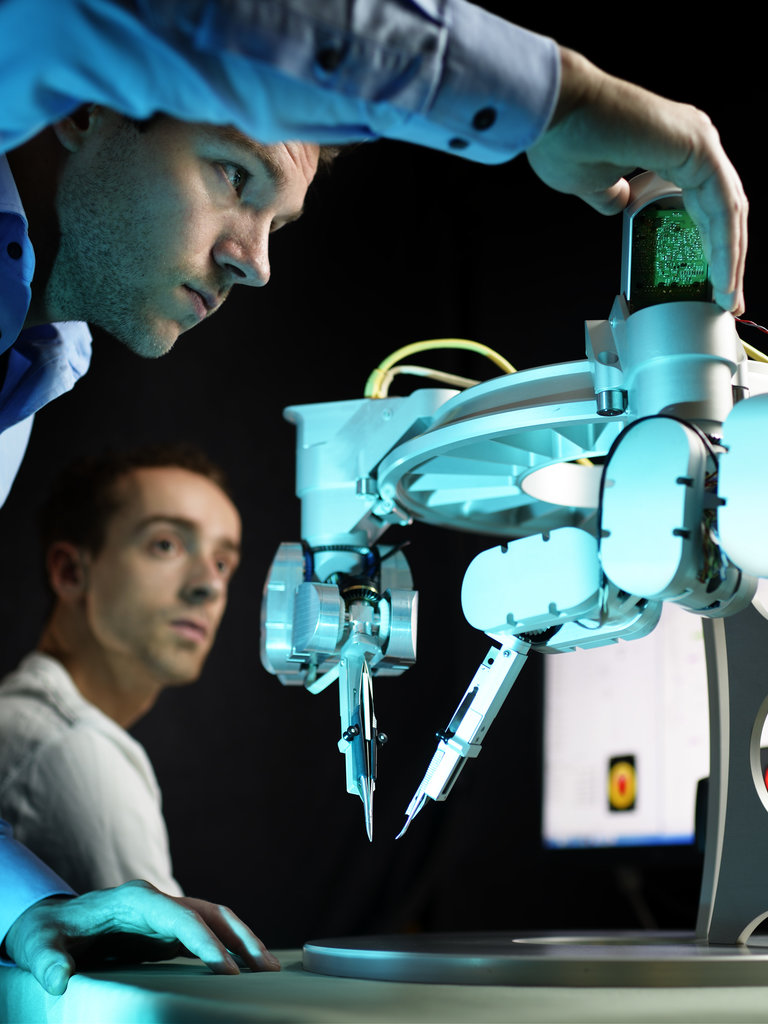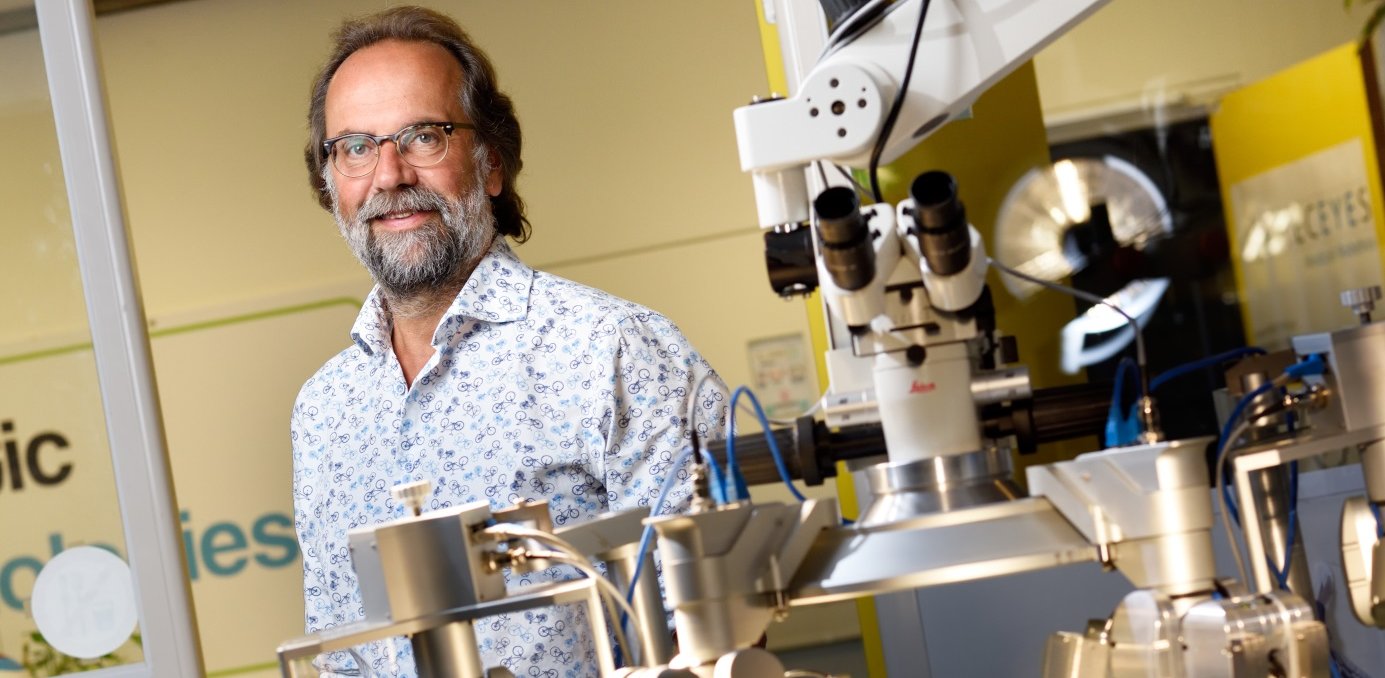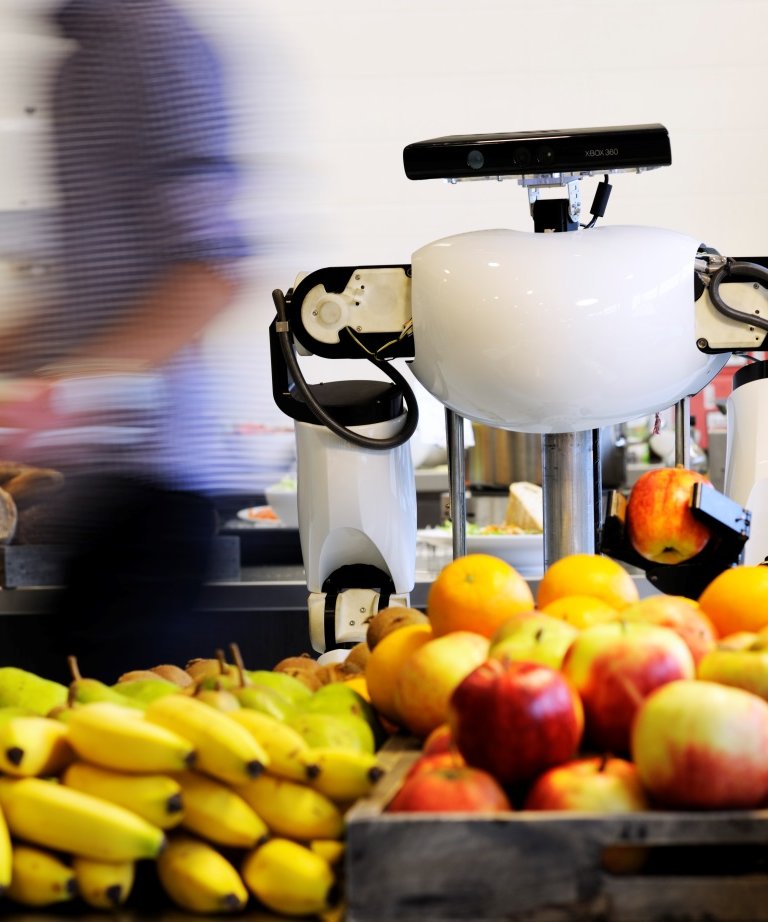
Robotics in the Netherlands
4TU robotics professors discuss research, technology transfer and entrepreneurship
By Jurjen Slump
The four technical universities in the Netherlands (collectively known as the 4TU) excel in the field of robotics research. They even lead the international field in specific areas such as agro-robotics and medical robots. While the differences between the universities are often highlighted in the Netherlands, these differences are non-existent to parties overseas. What is the state of robotics in the Netherlands as a whole? How does this impact collaboration between the 4TU? And how good is the investment climate for robotics companies in the Netherlands?
In an interview with Home of Innovation, robotics professors Maarten Steinbuch (Eindhoven University of Technology), Stefano Stramigioli (University of Twente), Eldert van Henten (Wageningen University) and Martijn Wisse (Delft University of Technology) answer these questions, offering an impression of the current state of Dutch robotics.

The Netherlands and the world
The Netherlands is not traditionally a country associated with robotics. The best-known robot builders are those in countries that are home to large car manufacturers, such as Germany and Japan. The Netherlands focuses on next-generation robotics: robots with added intelligence or precision. In the future, these will appear everywhere: in homes, on the streets, on factory floors and in the fields. Several factors underlie the expectation that the Netherlands is set to play a major role in these developments.
Hierarchyless
When asked what makes the Netherlands unique, both Stramigioli and Wisse mention something that has nothing to do with technology. ‘Hierarchical contacts play a much less prominent role in society here’, argues Stramigioli, himself from Italy. ‘It is much easier to make contact, and people seek each other out.’ That is ‘extraordinary’ and equates to a great deal of potential, particularly for robotics research, being a field in which numerous disciplines unite. ‘In other countries, they are more likely to decide to form separate groups: one for the software, one for the electronics and one for the mechanics’, Wisse adds. In the Netherlands, people are ‘quicker to look across borders’ and seek out collaboration, which results in creative solutions.
Back to technology. The Netherlands holds a unique position with regard to high-tech systems, agro-food and medical robots. ‘We have extensive expertise with agricultural and horticultural products, and we shine in the high-tech construction industry’, Steinbuch says. ‘That means that we are very good at making systems extremely precise.’ To illustrate this, he – naturally – points to the football robots that have secured Eindhoven the world championship on numerous occasions. The exterior of these robots conceals an advanced system that allows them to understand the world around them.
Medical robotics is just as advanced. ‘We are able to design mechatronic precision, and regard robots as high-tech systems. This results in products and spin-offs like nowhere else in the world, such as our eye surgery and vascular surgery robots.’ These systems can perform operations with five to ten times more precision than human surgeons. ‘There is no other university or startup anywhere in the world that can do this’, Steinbuch says. This ‘high-quality mechatronic expertise’ is also praised by Stramigioli, who works on advanced medical robots as well, at the University of Twente.
Wisse also points to education in the Netherlands, another area in which the country stands out from the competition. Students receive an ‘extremely advanced’ education, exploring the entire robot system, both software and hardware. ‘It is of a high academic level.’ In both Delft and Twente, close attention is also paid to ethical concerns. ‘Even if you only consider regulations and ethical issues, you can see how important this aspect will become’, says Stramigioli.
Guiding country
Van Henten emphasises the Netherlands’ position as a frontrunner in agro-robotics, ascribing the country a ‘guiding role’ in the field. One familiar example is Lely’s robotic milking system: the first major hit scored for robots operating in a more complex working environment. At Wageningen, work started on agro-robotics back in the mid-1990s. The role that robots can play in satisfying rising demand for food and with regard to sustainability is now becoming increasingly clear. As a result, there is rising international interest in what is happening at Wageningen in this field.
The challenge facing the agrarian sector is focused on the automation of complex tasks. ‘All of the simple things have already been mechanised. Planting machines, cutting machines, repotting machines, you name it. It’s all available.’ The challenge lies in the complex tasks that are currently still being completed by humans, such as deciding what should be harvested and when. It is the automation of human decision-making. Besides that, all of the hardware needs to be able to resist farming conditions and be resistant to dust, mud and rain. It has to be robust.
Tipping point
Nonetheless, Wisse believes that the ‘truly major success stories’ are yet to come. The technology to make robots intelligent, allowing them to enter our daily lives through a range of applications, has not been around for long. ‘To be honest, we are still to see this technology deliver results’, Wisse says. He predicts the Netherlands will be ‘extremely good’ in this field, thanks to the multidisciplinary collaboration he already praised before. ‘We are at a tipping point. Robots are moving out of factories and into our daily lives, and the Netherlands can play a prominent role in this development.’
Research at Delft University of Technology focuses on the interaction between robots and the people around them – an issue that was not relevant to factory environments. Research at the other three universities is also focused on robots that are capable of functioning in ‘unstructured environments’.
So, the Netherlands leads the way in several fields. But the competition is fierce. ‘There are an inconceivable number of robotics groups scattered around the world’, says Steinbuch. ‘Huge amounts of money are being invested in Japan, Germany, Italy and the US.’ In this light, it would be a stretch to say that the Netherlands holds a unique position. The total research funding available in the Netherlands is too limited to reach first place on a global scale. ‘But, having said that, we took home the world championship for robot football for the third time.’ Such victories attract interested parties from all over the world.
Stramigioli also calls for realism. The Netherlands is primarily a world player in certain areas. The University of Twente’s particular area of expertise is pipeline inspection and advanced MRI-compatible medical robots. ‘In several countries, high-level research is being conducted into the new generation of intelligent robotics’, Wisse says. ‘The Netherlands is one of these breeding grounds.’

4TU: Standing united?
If the Netherlands is to become a leading robotics country, it is vital that the 4TU collaborate effectively, and particularly that they present a united front to countries overseas. ‘From the perspective of Shanghai, the Netherlands is no larger than a postage stamp’, explains Steinbuch. Working together is the ideal means of facilitating acceleration. In recent years, this collaboration was sometimes tough going. Collaboration within RoboNED was sound, but hit a rough patch during the past few years – partly because the individual universities were primarily focused on promoting themselves.
Things have improved: under the title of ‘Holland Robotics’ consultations between the universities are gaining more shape. ‘We have entered a phase in which we accept that we are all promoting ourselves, but we have once again set our sights on finding the added value. I am pleased with this development.’
Bundling strengths
Stramigioli welcomes the renewed initiatives for collaboration. ‘I think it is a good idea to present a single face to the world outside and to bundle our strengths’, he says. ‘That is what is most important: that everyone has the opportunity to showcase their strengths, but not at the expense of the others. You have to realise that we can achieve much more by working together.’
‘The opportunities for us are fantastic’, Van Henten enthuses. ‘The Netherlands is a small country. I think that, with respect for each other’s expertise, we need to find ways of working together. Because the Netherlands is home to an absolutely enormous amount of expertise.’
Other universities
Steinbuch also expressly includes the non-technical universities: those of Tilburg, Amsterdam, Nijmegen and Utrecht. These universities have a completely different perspective on robotics, paying attention to the social and legal aspects. ‘I always hope that people complement each other sufficiently in the research so that they actually help each other.’ Wisse says that this often happens automatically. ‘It manages itself, as you are never going to do the same as your colleague – that would make it difficult for you to get ahead, after all. Researchers always look for something that nobody else is already doing.’ When it comes to agro-robotics, Van Henten sees innumerable opportunities for collaboration. The vision systems developed by the TU/e for their football robots could be put to good use in robots for picking fruit. Delft is home to Lacquey, a company that specialises in the field of grippers – also required for the same picking robot.

Care robot Amigo
Technology transfer
If the Netherlands is to become one of the leading countries in the field of robotics, successful collaboration with the business world and the government is essential, as is a healthy investment climate. In this respect, the professors are predominantly positive. They do believe that a long-term vision is sometimes lacking, however, and are critical of the government’s so-called top sector policy, which they believe negatively impacts robotics.
The idea behind the policy was that the business world would increase investment in R&D. However, Steinbuch explains that there are too few robotics companies in the Netherlands to ensure a flow of research funds. ‘Consequently, the whole top sector approach does not work for new enterprises, such as robotics.’
‘It is underpinned by extremely limited long-term vision,’ Van Henten agrees. ‘The industry looks no more than a few years ahead, while we are talking about scientific research that spans a period of ten or fifteen years.’ The Wageningen University professor thinks that the government has an ‘inadequate’ understanding of the importance of technology for agriculture and of the role that his university can play in this regard. He appeals to the government to show a higher level of ‘structural involvement.’
Start-ups
Recent Times Higher Education research revealed that Eindhoven Uni- versity of Technology is world leader when it comes to collaborating with the most innovative companies. ‘We have an unbelievable number of start-ups here,’ says Steinbuch, who is personally involved with Preceyes and MicroSure, two companies that manufacture medical robots.
He has ambitious plans for Eindhoven region, both regarding the research into medical robots and the business side of things. ‘I am consulting with investors on how to take things to the next level, and far beyond. In a recent column, I wrote that in a decade’s time, I want to see 1,000 people working in this field in this region. That is my ambition.’
Stramigioli points to the University of Twente’s more than 900 spin-offs, including robotics company Clear Flight Solutions. They manufacture the Robird, a robotic bird that can be used at airports to scare away other (non-robotic) birds that could otherwise cause problems for air traffic. During the CES technology fair in Las Vegas, TechCrunch magazine praised the Robird as one of the ten ‘coolest gadgets.’ Delft is a familiar face on the scene thanks to RoboValley, and there is now also plenty of focus on start-ups in Wageningen.
Venture capital
A lack of venture capital is unanimously identified as one of the most significant problems. ‘The only thing missing is a huge pile of money,’ Steinbuch says. Stramigioli agrees, noting that finding investors is the greatest challenge. ‘Silicon Valley did not become what it is today because the people there are better than people in the Netherlands, but rather because it is much easier to secure capital, because entrepreneurs dare to take more risks and are not afraid of failing.’
Wisse brings up the lengthy development phase associated with robotics, which means that investors need to be patient. Robots comprise software and hardware, and it is primarily the development of the mechanical part that takes so much time. An additional issue is that each new robot has to be designed and tested individually. It takes ‘an awful lot of time and money’ before it actually works. All burgeoning robotics companies have to make their way through this protracted development process. ‘And that always involves sums up- wards of €1 million,’ says Wisse.
Steinbuch thinks that a fund should be established to address the problem. Start-ups could then apply for funding to help them through the challenging initial period. ‘Once you have secured a loan, that is when things really start to happen.’ Stimulating entrepreneurship
While it is easy to set up a company in the Netherlands, Steinbuch would like to see more done to improve the links between research and entrepreneurship. He is not concerned about the educational programme, but rather about how entrepreneurship is perceived. ‘I see that students are extremely ambitious, but this ambition is sometimes smothered by academic staff who attach greater importance to publications.’
When all is said and done, the government has a responsibility to stimulate substantive social discussion regarding the future of intelligent robots. Wisse thinks that once the population’s fear is quelled, people will be more inclined to purchase a robot.
Liberation
Robots could result in job losses, but – paradoxically – they could in fact be the saviour of the agriculture industry. The agrarian sector has struggled with a shortage of workers for years, and fewer and fewer people want to become farmers.
Because they do not fancy getting up at the crack of dawn to milk the cows, for example. But if robots in ‘intelligent sheds’ take over this demanding work, there is hope, Van Henten says. ‘Perhaps the younger generation, those who have grown up playing computer games, will gain a fresh in- terest in agriculture, precisely due to all of the technology.’ The farmer of the future will be a systems administrator, strolling through his fields, iPad in hand.
Wisse is also optimistic. He suggests a comparison with the washing machine. Before that was invented, women spent endless hours plugging away in a washtub. And, just as the washing machine offered many women liberation, robots will bring liberation in other fields. ‘Robots will expedite future liberation from all sorts of boring and physically demanding work.’